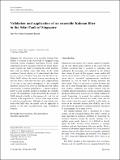Validation and application of an ensemble Kalman filter in the Selat Pauh of Singapore
Author(s)
Wei, Jun; Rizzoli, Paola M
DownloadOD_2009.pdf (210.3Kb)
OPEN_ACCESS_POLICY
Open Access Policy
Creative Commons Attribution-Noncommercial-Share Alike
Terms of use
Metadata
Show full item recordAbstract
The effectiveness of an ensemble Kalman filter (EnKF) is assessed in the Selat Pauh of Singapore using observing system simulation experiment. Perfect model experiments are first considered. The perfect model experiments examine the EnKF in reducing the initial perturbations with no further errors than those in the initial conditions. Current velocity at 15 observational sites from the true ocean is assimilated every hour into the false ocean. While EnKF reduces the initial velocity error during the first few hours, it fails after one tidal cycle (approximately 12 h) due to the rapid convergence of the ensemble members. Successively, errors are introduced in the surface wind forcing. A random perturbation ε [epsilon] is applied independently to each ensemble member to maintain the ensemble spread. The assimilation results showed that the success of EnKF depends critically on the presence of ε [epsilon], yet it is not sensitive to the magnitude of ε [epsilon], at least in the range of weak to moderate perturbations. Although all experiments were made with EnKF only, the results could be applicable in general to all other ensemble-based data assimilation methods.
Date issued
2009-12Department
Massachusetts Institute of Technology. Department of Earth, Atmospheric, and Planetary SciencesJournal
Ocean Dynamics
Publisher
Springer
Citation
Wei, Jun, and Paola Malanotte-Rizzoli. “Validation and Application of an Ensemble Kalman Filter in the Selat Pauh of Singapore.” Ocean Dynamics 60.2 (2010) : 395-401-401. Copyright © 2009, Springer-Verlag
Version: Author's final manuscript
ISSN
1616-7228